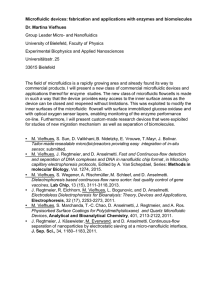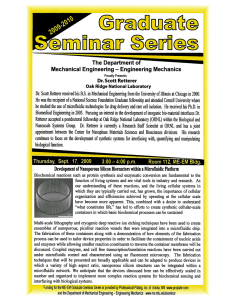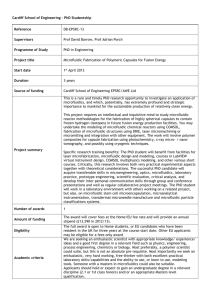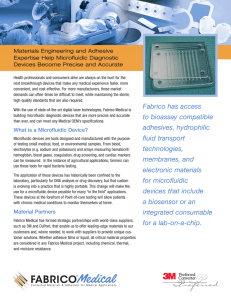as PDF
advertisement
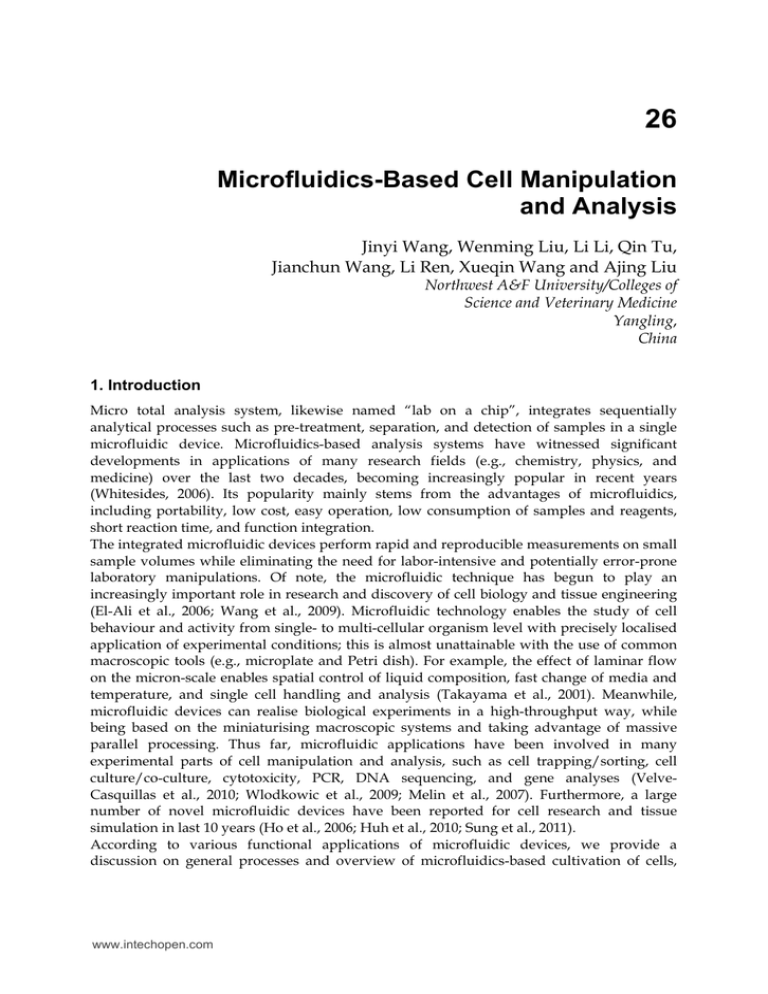
26 Microfluidics-Based Cell Manipulation and Analysis Jinyi Wang, Wenming Liu, Li Li, Qin Tu, Jianchun Wang, Li Ren, Xueqin Wang and Ajing Liu Northwest A&F University/Colleges of Science and Veterinary Medicine Yangling, China 1. Introduction Micro total analysis system, likewise named “lab on a chip”, integrates sequentially analytical processes such as pre-treatment, separation, and detection of samples in a single microfluidic device. Microfluidics-based analysis systems have witnessed significant developments in applications of many research fields (e.g., chemistry, physics, and medicine) over the last two decades, becoming increasingly popular in recent years (Whitesides, 2006). Its popularity mainly stems from the advantages of microfluidics, including portability, low cost, easy operation, low consumption of samples and reagents, short reaction time, and function integration. The integrated microfluidic devices perform rapid and reproducible measurements on small sample volumes while eliminating the need for labor-intensive and potentially error-prone laboratory manipulations. Of note, the microfluidic technique has begun to play an increasingly important role in research and discovery of cell biology and tissue engineering (El-Ali et al., 2006; Wang et al., 2009). Microfluidic technology enables the study of cell behaviour and activity from single- to multi-cellular organism level with precisely localised application of experimental conditions; this is almost unattainable with the use of common macroscopic tools (e.g., microplate and Petri dish). For example, the effect of laminar flow on the micron-scale enables spatial control of liquid composition, fast change of media and temperature, and single cell handling and analysis (Takayama et al., 2001). Meanwhile, microfluidic devices can realise biological experiments in a high-throughput way, while being based on the miniaturising macroscopic systems and taking advantage of massive parallel processing. Thus far, microfluidic applications have been involved in many experimental parts of cell manipulation and analysis, such as cell trapping/sorting, cell culture/co-culture, cytotoxicity, PCR, DNA sequencing, and gene analyses (VelveCasquillas et al., 2010; Wlodkowic et al., 2009; Melin et al., 2007). Furthermore, a large number of novel microfluidic devices have been reported for cell research and tissue simulation in last 10 years (Ho et al., 2006; Huh et al., 2010; Sung et al., 2011). According to various functional applications of microfluidic devices, we provide a discussion on general processes and overview of microfluidics-based cultivation of cells, www.intechopen.com 560 On Biomimetics manipulation and analyses of plant cell fusion, cell-drug interactions, and cell-to-cell interactions. Monitoring of cell behaviour and precise control of cell microenvironments are intentionally mentioned as well. 2. Cell culture Cell culture is the complex process by which cells are grown under controlled conditions. The cell culture methods used in this study is founded on over a century of scientific work. Although characterisation of microfluidic-based cell culture continues to develop, the multiple aspects of microfluidic environments have been understood and controlled. Microfluidic devices are suitable for biological applications, particularly on the cellular level, because of scale similarity between microchannels and cells. Scale of devices allows important factors (e.g., growth factors) to accumulate locally, forming a stable microenvironment for cell culture. Furthermore, the physical design of microfluidic devices affects the cell microenvironment of cultured cells. Design considerations and effective culture volume are useful for cellular control over the microenvironment in the microdevice. Engineering and applications of microfluidics, two- and three- dimensional culture of cells have been both described recently (Meyvantsson et al., 2008; Wu et al., 2010). In this section, we mainly present the diversified cultivation works to date on both mammalian cells, bacteria, and plant cells using microfluidic devices. In the past 10 years, microfluidic-based applications of cell cultivation have ranged from many cell types from different tissues (e.g., epithelium and muscle) (Tourovskaia et al., 2005; Leclerc et al., 2006; Cimetta et al., 2009), organs (e.g., liver, lung, and kidney) (Zhang et al., 2008; Jang et al., 2010; Hoganson et al., 2011), even species (e.g., rat, cattle, human, and Nicotiana tabacum) (Ring et al., 2010; Taylor et al., 2005; Lee et al., 2006; Ko et al., 2006). Commonly, microfluidic culture modes of cells include the perfusion culture (continuous flow), half-perfusion culture (molecular diffusion with persistent supply of nutrients), and static culture (molecular diffusion). The perfusion culture is a popular application for the growth and proliferation of adherent cells. Low shear stress from microfluid in the channel leads to nearly no injury to the normal activities of these cell types. Compared with static culture, the perfusion culture of cells cannot only keep the culture system sterile during the entire culture period. More importantly, however, it continuously provides a system for nutrient supply and waste removal, thus keeping the culture environment more stable. This contributes to steadier and more quantifiable extracellular conditions, which are particularly meaningful to the following cell-based research on microfluidic devices. Luke et al. presented a microfluidic cell culture array for long-term culture and monitoring of human carcinoma cells (Hela cells) at 37 oC (Hung et al., 2005). Major functions of the device include reagent introduction, cell growth, cell passage, and real-time optical analysis based on the perfusion model. The cell culture array can offer a platform for a wide range of assays, with applications in bioinformatics and quantitative cell biology. Yu et al. (Zhang et al., 2009) developed a multichannel three-dimensional microfluidic cell culture system (multi-channel 3D-µFCCS) with compartmentalised microenvironments. To this end, the multi-channel 3D-mFCCS was designed for culturing different 3D cellular aggregates simultaneously to mimic multiple organs in the body. Four human cell types (C3A, A549, HK-2, and HPA cells) were chosen to represent the liver, lung, kidney, and adipose tissue, respectively. Cellular functions were optimised by supplementing the common medium with growth factors. Such a multi-channel 3D-mFCCS www.intechopen.com Microfluidics-Based Cell Manipulation and Analysis 561 may be potentially used to supplement or even replace animal models in drug screening. However, certain highly environment-sensitive cell types such as neuron are always maintained and cultured in the static or half-perfusion microenvironment of the devices (Hosmane et al., 2010). Meanwhile, diffusion is likewise used for the suspension culture of cells such as bacteria (Escherichia coli) and plant cells (tobacco mesophyll protoplasts) (Ko et al., 2006; Sun et al., 2011), which requires greater control in the devices due to non-physical dependence. Fig. 1. Configuration and function of the microfluidic device. A. Schematic representation of the device with five culture chambers arranged in a pentagonal array and applied for the parallel culture of protoplasts. A center sample input was designed for the introduction of various liquids, including protoplast suspension, rinsing solution, culture medium, and dye. The square in the red dotted line corresponds to B. Double micro-column lines in each chamber were designed to promote trapping of protoplasts while the seeding process (B). The gap between micro-columns was 20 µm. C. Plan (up) and elevation (down) of the microfluidic device. Hydrostatic pressure was used to realize material transportation using a small volume difference. D-I. Chemical fusion of the tobacco mesophyll protoplasts was performed in the microfluidic device using polyethylene glycol (PEG). The time when the two protoplasts contacted is considered as the start of fusion (i.e., 0 s) (D), followed by 10 s (E), 30 s (F), 50 s (G), 80 s (H), and 190 s (I). www.intechopen.com 562 On Biomimetics Application of microfluidics in the field of plant cell biology is close to nil. Recent microfluidic advances in plant cell research contain the preliminary cultivation of protoplasts, the relationship between high air permeability of polydimethylsiloxane (PDMS) and protoplasts, and fusion manipulation of protoplasts as well (Ju et al., 2006; Wu et al., 2010). The protoplasts became vulnerable in the in vitro environments as they were separated from the protection of cell walls. The highly spatiotemporal control of microenvironment is necessary to maintain the viability and activities of protoplasts during primary culture. Based on the optimal supplication of nutrients and design of microfluidic devices, growth up to formation of visible cell mass was achieved recently in the microfluidic cultivation of protoplasts (Wu et al., 2010). On-chip protoplast culture showed that percentage of the first division may be improved to as high as 85.6% in five days. 3. Plant cell fusion As typical genetic manipulation in plant cell engineering, cell fusion (i.e., protoplast fusion) has been used for various purposes, including generation of hybrids and reprogramming of somatic cells. Cell fusion, generally called somatic cell hybridisation, is an excellent tool for breeding and genetic analysis of engineered plants (Ogle et al., 2005). To expand microfluidic application in plant cell manipulation, Wang et al. presented a conceptual attempt at protoplast fusion in the microfluidic device (Figure 1) (Wu et al., 2010). Tobacco mesophyll protoplast fusion was performed through polyethyleneglycol (PEG)-induced fusion. The results revealed that adjacent protoplasts came into close contact with one another, and membrane of the contacted protoplasts fused. Therefore, a connection was formed between the two cytoplasms. Components of both contacted protoplasts, especially the chloroplasts, mixed and combined with one another. Finally, the two protoplasts formed a fusion product with an irregular shape, which was different from the common spherical shape. The possible reason for deformation can be the spatially mechanical response of the fusion body in the microfluidic device because of increased volume. Total duration of this fusion in the microfluidic device merely took approximately 3–5 min, achieving a fusion rate of 28.8%. This result is similar to the conventional fusion in a macroscale culture environment. 4. Cell-to-chemical stimuli interactions In vitro cell-based assays have been regarded as a promising substitute to in vivo animal testing in research on cell and chemical materials (e.g., drugs). Ideally, a cell culture model faithful to in vivo behaviour offers significant advantages in saving time and cost in cellbased research. Microfluidics, which has been demonstrated to provide a biologically relevant and well-defined cellular microenvironment, is needed to maintain the phenotypic properties of tested cells; this is necessary to investigate faithfully and precisely the cellular response to specific drug compounds or conditions. The inherent cellular microenvironments mimicked in a microfluidic system suggested that research on cell-tochemical stimuli interactions can be performed in a microscale, high throughput, and physiologically meaningful manner. Most microfluidic cell culture systems used in this research exploit a perfusion cell culture format in which medium flows are not only used to feed cultured cells continuously but likewise to provide additional functionalities such as generating gradients of drug concentrations (Wu et al., 2010; van Midwoud et al., 2010; www.intechopen.com Microfluidics-Based Cell Manipulation and Analysis 563 Sugiura et al., 2008), creating a specific physical microenvironment (e.g., shear stress or interstitial fluid flow) and constructing a circulatory system to mimic in vivo conditions better. Fig. 2. Cellular responses of rat C6 glioma cells to colchicine treatment (0.5 µg/ml): (A) Rat C6 glioma cells cultured for 2 days; (B) Rat C6 glioma cells treated with colchicine for 60 h; (C) Fluorescence image of PI-stained rat C6 glioma cells for cell viability assessment after colchicine treatment for 60 h; a–l cellular responses of rat C6 glioma cells after 0.5 µg/ml colchicine introduction (0, 15, 30, 60, 90, 140, 180, 210, 420 min, 24 h, 48 h, and 60 h). Wang et al. developed a glioma-related microfluidic method for studying brain tumour therapy (Liu et al., 2010). Glioma cells were cultured successfully for up to seven days in a microfluidic device, and cellular responses to the anticancer drug (colchicine) were monitored in real time (Figure 2), followed by the analyses of cell viability by using www.intechopen.com 564 On Biomimetics propidium iodide (PI) staining. Temporal changes in cell morphology at various concentrations of colchicine were recorded using an inverted microscope and charged coupled device (CCD) imaging. According to results, the number of injured/dead cancer cells and morphological changes increased relative to the drug’s concentration and treatment frequency. The achievement is helpful in developing microfluidic device applications for future research on brain tumour, conducting cytotoxicity research in a biomimetic microenvironment, developing glioma-related anticancer drugs, and developing glial cell-based biosensors for glioma detection. 5. Cell-microenvironmental interactions Extracellular environment provides important and necessary conditions for cell proliferation, differentiation, metabolism, and functional activities; it determines cell behaviour (e.g., cell polarisation and migration) and fate (i.e., survival or death). Actually, cell-microenvironmental interactions (cell-to-matrix, cell-to-cell, and cell-to-soluble factors) are known to occur in many physiological and patho-physiological processes such as embryological development, wound healing, tumour invasion, and metastasis (Gurtner et al., 2008; Bhowmick et al., 2004; Bullock et al., 2001). Due to their specific occurrence and progress, a spatio-temporal controlled investigation in vitro and the understanding of these valuable and interesting biological cues are of great importance to cell biology and histology. Microfluidics is becoming a promising platform for the study of cell-microenvironmental interactions, mainly because of its excellent performance in precise control, monitoring, and manipulating cells and their microenvironments in vitro in a spatial and temporal manner. Recently, several microfluidic systems have shown good real-time manipulation of cell culture and cellular responses to simultaneous stimulation of soluble cues (Gómez-Sjöberg et al., 2007; Park et al., 2010), and an excellent microfluidic system for studying mammalian cells in 3D microenvironments has presented one of its possible utilities in the study of cellcell communication (Lii et al., 2008). Ingenious design and real-time manipulation of microfluidic system play an important role for versatile studies of cell-microenvironmental interactions, especially the serial and dynamic procedures of these studies. Furthermore, it is notable that perfusion cell cultures may hamper cell-to-cell communication through intrinsic and extrinsic growth factors because of the continuous washing away of these biomolecules. Wang et al. presented an integrated microfluidic system for dynamic study of cellmicroenvironmental interactions (Figure 3) (Liu et al., 2010). They demonstrated its precise spatio-temporal control in the flow direction and multisite staying of fluids by groups of monolithic microfabricated valves through digital operation, in addition to the regulated communication between two loci based on real-time microenvironment transition. Using this system, a series of functional manipulations, including specific delivery, addressable surface treatment, positional cell loading, and co-culture were performed quickly and efficiently for biological applications. Sequentially, they performed the potential utility of this system in research on dynamic microenvironmental influence to cells using a patho-physiological interaction during cancer initiation and progression. The results exhibit the passive role but collaborative response of NIH 3T3 fibroblasts to the soluble signals from hepatocellular carcinoma cells, as well as the variable behaviours of carcinoma cells under different environmental stimulations. This system can facilitate the in vitro investigation of cellmicroenvironmental interactions occurring in numerous biological and pathogenic processes. www.intechopen.com Microfluidics-Based Cell Manipulation and Analysis 565 Fig. 3. Configuration of the integrated microfluidic system. (A) Schematic representation of the functional circuit used for cell-microenvironmental interactions. The responsibilities of different valves are illustrated by their colors: red for regular valves (for isolation) and yellow valves (for communication of the adjacent chambers). (B) Optical image of the actual device. The various channels were loaded with food dyes to help visualize the different components of the microfluidic chip; the colors correspond to those in (A), with green indicating the fluidic channels. (C) Composition of the microfluidic device (four layers sequentially from top to bottom, including the fluidic layer, control layer, thin PDMS layer, and glass slide). 6. Conclusions After a decade of development, microfluidics has demonstrated its capability to serve as a powerful tool for cell manipulation and analysis. Successful applications of microfluidics for cell-based assay – including cell lysis chip, cell culture chip, electroporation chip, biochemical sensing chip, and whole cell sensing chip – have revolutionised the way we approach the subject. Single cell-based microfluidic devices for various excellent experiments will be the future direction of this research area. Meanwhile, diversified development can be the major strategy for the application of microfluidics to life science in the next two decades. www.intechopen.com 566 On Biomimetics 7. Acknowledgment This work was supported by the National Natural Science Foundation of China (No. 209 750 82; No. 207 750 59), the Ministry of Education of the People’s Republic of China (NCET-080464), the State Forestry Administration of the People’s Republic of China (No. 200904004), the Scientific Research Foundation for the Returned Overseas Chinese Scholars, State Education Ministry, and Northwest A&F University. 8. References Bhowmick, N.A.; Neilson, E.G. & Moses, H.L. (2004). Stromal fibroblasts in cancer initiation and progression. Nature, Vol.432, No.7015, (November 2004), pp. 332-337, ISSN 0028-0836 Bullock, S.L. & Ish-Horowicz, D. (2001). Conserved signals and machinery for RNA transport in Drosophila oogenesis and embryogenesis. Nature, Vol.414, No.6864, (December 2001), pp. 611-616, ISSN 0028-0836 Cimetta, E.; Pizzato, S.; Bollini, S.; Serena, E.; De Coppi, P. & Elvassore, N. (2009). Production of arrays of cardiac and skeletal muscle myofibers by micropatterning techniques on a soft substrate. Biomedical Microdevices, Vol.11, No.2, (April 2009), pp. 389-400, ISSN 1387-2176 El-Ali, J.; Sorger, P.K. & Jensen, K.F. (2006). Cells on chips. Nature, Vol.442, No.7101, (July 2006), pp. 403-411, ISSN 0028-0836 Gómez-Sjöberg, R.; Leyrat, A.A.; Pirone, D.M.; Chen, C.S. & Quake, S.R. (2007). Versatile, fully automated, microfluidic cell culture system. Analytical Chemistry, Vol.79, No.22, (November 2007), pp. 8557-8563, ISSN 0003-2700 Gurtner, G.C.; Werner, S.; Barrandon, Y. & Longaker, M.T. (2008). Wound repair and regeneration. Nature, Vol.453, No.7193, (May 2008), pp. 314-321, ISSN 0028-0836 Ho, C.T.; Lin, R.Z.; Chang, W.Y.; Chang, H.Y. & Liu, C.H. (2006). Rapid heterogeneous livercell on-chip patterning via the enhanced field-induced dielectrophoresis trap. Lab on a Chip, Vol.6, No.6, (June 2006), pp. 724-734, ISSN 1473-0197 Hoganson, D.M.; Pryor II, H. I.; Bassett, E. K.; Spool, I. D. & Vacanti, J. P. (2011). Lung assist device technology with physiologic blood flow developed on a tissue engineered scaffold platform. Lab on a Chip, Vol.11, No.4, (February 2011), pp. 700-707, ISSN 1473-0197 Hosmane, S.; Yang, I.H.; Ruffin, A.; Thakor, N. & Venkatesan, A. (2010). Circular compartmentalized microfluidic platform: Study of axon-glia interactions. Lab on a Chip, Vol.10, No.6, (March 2010), pp. 741-747, ISSN 1473-0197 Huh, D.; Matthews, B.D.; Mammoto, A.; Montoya-Zavala, M.; Hsin, H.Y. & Ingber, D.E. (2010). Reconstituting organ-level lung functions on a chip. Science, Vol.328, No.5986, (June 2010), pp. 1662-1668, ISSN 0036-8075 Hung, P.J.; Lee, P.J.; Sabounchi, P.; Lin, R. & Lee, L.P. (2005). Continuous perfusion microfluidic cell culture array for high-throughput cell-based assays. Biotechnology and bioengineering, Vol.89, No.1, (January 2005), pp. 1-8, ISSN 0006-3592 Jang, K.J. & Suh, K.Y. (2010). A multi-layer microfluidic device for efficient culture and analysis of renal tubular cells. Lab on a Chip, Vol.10, No.1, (January 2010), pp. 36-42, ISSN 1473-0197 www.intechopen.com Microfluidics-Based Cell Manipulation and Analysis 567 Ju, J.; Ko, J.; Kim, S.; Baek, J.; Cha, H. & Lee, S. (2006). Soft material-based microculture system having air permeable cover sheet for the protoplast culture of Nicotiana tabacum. Bioprocess and biosystems engineering, Vol.29, No.3, (August 2006), pp. 163168, ISSN 1615-7591 Ko, J.M.; Ju, J.; Lee, S. & Cha, H.C. (2006). Tobacco protoplast culture in a polydimethylsiloxane-based microfluidic channel. Protoplasma, Vol.227, No.2-4, (May 2006), pp. 237-240, ISSN 0033-183X Leclerc, E.; David, B.; Griscom, L.; Lepioufle, B.; Fujii, T.; Layrolle, P. & Legallaisa, C. (2006). Study of osteoblastic cells in a microfluidic environment. Biomaterials, Vol.27, No.4, (February 2006), pp. 586-595, ISSN 0142-9612 Lee, P.J.; Hung, P.J.; Rao, V.M. & Lee, L.P. (2006). Nanoliter scale microbioreactor array for quantitative cell biology. Biotechnology and bioengineering, Vol.94, No.1, (May 2006), pp. 5-14, ISSN 0006-3592 Lii, J.; Hsu, W.J.; Parsa, H.; Das, A.; Rouse, R. & Sia, S.K. (2008). Real-time microfluidic system for studying mammalian cells in 3D microenvironments. Analytical Chemistry, Vol.80, No.10, (May 2008), pp. 3640-3647, ISSN 0003-2700 Liu, W.; Li, L.; Wang, X.; Ren, L.; Wang, J.C.; Tu, Q.; Huang, X. & Wang, J. (2010). An integrated microfluidic system for studying cell-microenvironmental interactions versatilely and dynamically. Lab on a Chip, Vol.10, No.13, (July 2010), pp. 1717-1724, ISSN 1473-0197 Liu, W.; Sun, P.; Yang, L.; Wang, J.F.; Li, L. & Wang, J. (2010). Assay of glioma cell responses to an anticancer drug in a cell-based microfluidic device. Microfluidics and Nanofluidics, Vol.9, No.4-5, (March 2010), pp. 717-725, ISSN 1613-4982 Melin, J. & Quake, S.R. (2007). Microfluidic large-scale integration: the evolution of design rules for biological automation. Annual Review of Biophysics and Biomolecular Structure, Vol.36, (June 2007), pp. 213-231, ISSN 1056-8700 Meyvantsson, I. & Beebe, D.J. (2008). Cell culture models in microfluidic systems. Annual Review of Analytical Chemistry, Vol.1, (March 2008), pp. 423-449, ISSN 1936-1327 Ogle, B.M.; Cascalho, M. & Platt, J.L. (2005). Biological implications of cell fusion. Nature reviews. Molecular cell biology, Vol.6, No.7, (July 2005), pp. 567-575, ISSN 1471-0072 Park, E.S.; Brown, A.C.; DiFeo, M.A.; Barker, T.H. & Lu, H. (2010). Continuously perfused, non-cross-contaminating microfluidic chamber array for studying cellular responses to orthogonal combinations of matrix and soluble signals. Lab on a Chip, Vol.10, No.5, (March 2010), pp. 571-580, ISSN 1473-0197 Ring, A.; Gerlach, J.; Peters, G.; Pazin, B.J.; Minervini, C.F.; Turner, M.E.; Thompson, R.L.; Triolo, F.; Gridelli, B. & Miki, T. (2010). Hepatic maturation of human fetal hepatocytes in four-compartment three-dimensional perfusion culture. Tissue engineering. Part C, Methods, Vol.16, No.5, (October 2010), pp. 835-845, ISSN 19373384 Sugiura, S.; Edahiro, J.; Kikuchi, K.; Sumaru, K. & Kanamori, T. (2008). Pressure-driven perfusion culture microchamber array for a parallel drug cytotoxicity assay. Biotechnology and bioengineering, Vol.100, No.6, (August 2008), pp. 1156-1165, ISSN 0006-3592 Sun, P.; Liu, Y.; Sha, J.; Zhang, Z.; Tu, Q.; Chen, P. & Wang, J. (2011). High-throughput microfluidic system for long-term bacterial colony monitoring and antibiotic testing www.intechopen.com 568 On Biomimetics in zero-flow environments. Biosensors and Bioelectronics, Vol.26, No.5, (January 2011), pp. 1993-1999, ISSN 0956-5663 Sung, J.H.; Yu, J.; Luo, D.; Shuler, M.L. & March, J.C. (2011). Microscale 3-D hydrogel scaffold for biomimetic gastrointestinal (GI) tract model. Lab on a Chip, Vol.11, No.3, (February 2011), pp. 389-392, ISSN1473-0197 Takayama, S.; Ostuni, E.; LeDuc, P.; Naruse, K.; Ingber, D.E. & Whitesides, G.M. (2001). Laminar flows: Subcellular positioning of small molecules. Nature, Vol.411, No.6841, (June 2001), pp. 1016, ISSN 0028-0836 Taylor, A.M.; Blurton-Jones, M.; Rhee, S.W.; Cribbs, D.H.; Cotman, C.W. & Jeon, N.L. (2005). A microfluidic culture platform for CNS axonal injury, regeneration and transport. Nature Methods, Vol.2, No.8, (July 2005), pp. 559-605, ISSN 1548-7091 Tourovskaia, A.; Figueroa-Masot, X. & Folch, A. (2005). Differentiation-on-a-chip: a microfluidic platform for long-term cell culture studies. Lab on a Chip, Vol.5, No.1, (June 2005), pp. 14-19, ISSN 1473-0197 van Midwoud, P.M.; Merema, M.T.; Verpoorte, E. & Groothuis, G.M. (2010). A microfluidic approach for in vitro assessment of interorgan interactions in drug metabolism using intestinal and liver slices. Lab on a Chip, Vol.10, No.20, (October 2010), pp. 2778-2786, ISSN 1473-0197 Velve-Casquillas, G.; Le Berre, M.; Piel, M. & Tran, P.T. (2010). Microfluidic tools for cell biological research. Nano Today, Vol.5, No.1, (February 2010), pp. 28-47, ISSN 1748-0132 Wang, J.Y.; Ren, L.; Li, L.; Liu, W.M.; Zhou, J.; Yu, W.H.; Tong, D.W. & Chen, S.L. (2009). Microfluidics: A new cosset for neurobiology. Lab on a Chip, Vol.9, No.5, (March 2009), pp. 644-652, ISSN 1473-0197 Whitesides, G.M. (2006). The origins and the future of microfluidics. Nature, Vol.442, No.7101, (July 2006), pp. 368-373, ISSN 0028-0836 Wlodkowic, D.; Faley, S.; Zagnoni, M.; Wikswo, J.P. & Cooper, J.M. (2009). Microfluidic single-cell array cytometry for the analysis of tumor apoptosis. Analytical Chemistry, Vol.81, No.13, (June 2009), pp. 5517-5523, ISSN 0003-2700 Wu, H.; Liu, W.; Tu, Q. ; Song, N.; Li, L.; Wang J.C. & Wang, J. (2010). Culture and chemicalinduced fusion of tobacco mesophyll protoplasts in a microfluidic device. Microfluidics and Nanofluidics, DOI 10.1007/s10404-010-0720-2, ISSN 1613-4982 Wu, M.H.; Huang, S.B. & Lee, G.B. (2010). Microfluidic cell culture systems for drug research. Lab on a Chip, Vol.10, No.8, (April 2010), pp. 939-956, ISSN 1473-0197 Zhang, C.; Zhao, Z.; Abdul Rahim, N.A.; van Noort, D. & Yu, H. (2009). Towards a humanon-chip: culturing multiple cell types on a chip with compartmentalized microenvironments. Lab on a Chip, Vol.9, No.22, (November 2009), pp. 3185-3192, ISSN 1473-0197 Zhang, M.Y.; Lee, P.J.; Hung, P.J.; Johnson, T.; Lee, L.P. & Mofrad, M.R. (2008). Microfluidic environment for high density hepatocyte culture. Biomedical Microdevices, Vol.10, No.1, (February 2008), pp. 117-121, ISSN 1387-2176 www.intechopen.com On Biomimetics Edited by Dr. Lilyana Pramatarova ISBN 978-953-307-271-5 Hard cover, 642 pages Publisher InTech Published online 29, August, 2011 Published in print edition August, 2011 Bio-mimicry is fundamental idea ‘How to mimic the Nature’ by various methodologies as well as new ideas or suggestions on the creation of novel materials and functions. This book comprises seven sections on various perspectives of bio-mimicry in our life; Section 1 gives an overview of modeling of biomimetic materials; Section 2 presents a processing and design of biomaterials; Section 3 presents various aspects of design and application of biomimetic polymers and composites are discussed; Section 4 presents a general characterization of biomaterials; Section 5 proposes new examples for biomimetic systems; Section 6 summarizes chapters, concerning cells behavior through mimicry; Section 7 presents various applications of biomimetic materials are presented. Aimed at physicists, chemists and biologists interested in biomineralization, biochemistry, kinetics, solution chemistry. This book is also relevant to engineers and doctors interested in research and construction of biomimetic systems. How to reference In order to correctly reference this scholarly work, feel free to copy and paste the following: Jinyi Wang, Wenming Liu, Li Li, Qin Tu, Jianchun Wang, Li Ren, Xueqin Wang and Ajing Liu (2011). Microfluidics-Based Cell Manipulation and Analysis, On Biomimetics, Dr. Lilyana Pramatarova (Ed.), ISBN: 978-953-307-271-5, InTech, Available from: http://www.intechopen.com/books/on-biomimetics/microfluidicsbased-cell-manipulation-and-analysis InTech Europe University Campus STeP Ri Slavka Krautzeka 83/A 51000 Rijeka, Croatia Phone: +385 (51) 770 447 Fax: +385 (51) 686 166 www.intechopen.com InTech China Unit 405, Office Block, Hotel Equatorial Shanghai No.65, Yan An Road (West), Shanghai, 200040, China Phone: +86-21-62489820 Fax: +86-21-62489821
